About this lesson
With our guitar tutorial on How to Read Guitar Tabs, you will learn these guitar skills: Guitar notes.
Guitar tabs (which is short for tablature) is a type of musical notation for stringed instruments that show you which fret to play on each string, as opposed to standard staff notation, which shows you the pitch of a note.
Beginner guitarists have a much easier time learning guitar from tablature, but in the long run, it’s a good idea to learn the standard musical notation as well.
It is very important to learn how to read guitar tabs. There are hundreds of thousands of tabs freely available on the Internet. Once you get to an intermediate guitar playing level and learn how to read tablature, you will be able to download the tabs for pretty much any song in the world. Some popular guitar tablature sites are Ultimate Guitar, GuitareTAB, and 911Tabs to name a few.
Quick Tablature Notation Reference Guide
Wondering what the all those symbols in guitar tabs mean? Here is a guick guide to help you.
h = hammer-on p = pull-off / = slide up \ = slide down s = slide b = bend r = reverse bend, or release bend t = right-hand tap x = muted/dampened string ~ or v = vibrato <5> = harmonic P.M. = palm muting (5) = ghost note, or optional note
Now let's go through everything you will see in guitar tablature in more detail.
Strings and Tabs
For the traditional 6 string guitar you will likely be using, the tablature will show 6 lines representing the 6 strings. The high E string is the first line, and the low E string is the bottom line. Its also important to note the tuning of the strings, which is given on the very left of each line.
Open String Tuning
E-------------- 1st string B-------------- 2nd string G-------------- 3rd string D-------------- 4th string A-------------- 5th string E-------------- 6th string
This is important since if a song’s tablature was written for drop D tuning, for example, it would not sound the same. Drop D tuning would look like this, notice the D on the bottom line showing you, that you need to tune that string down 1 whole note to a D.
Drop D Tuning
E-------------- 1st string B-------------- 2nd string G-------------- 3rd string D-------------- 4th string A-------------- 5th string D-------------- 6th string
Individual Notes in Guitar Tabs
The numbers on the lines represent the frets you are to play on each string. When you play each note separately, the number will follow each other like this.
E---------------------------------------- B---------------------------------------- G---------------------------------------- D-----------3---------------------------- A-------3-------------------------------- E---0------------------------------------
The above tablature means that first, you pluck the open low E string, then string A at fret 3, then string D at fret 3.
Simultaneous Notes, Chords in Guitar Tabs
2 or more numbers on top of each other means that you have to play those notes at the same time. The following example is an E major and a D major chord. Notice how no numbers are present on the strings you don’t pluck on the D chord
The person who wrote the tab (transcriber) might show the name of the chord above the numbers.
E D
E----0-------------2--------------------
B----0-------------3--------------------
G----1-------------2--------------------
D----2-------------0--------------------
A----2----------------------------------
E----0----------------------------------
Tablature Fingering and Rhythm
Tablature does not indicate what finger you should use to play each note. This is where most beginners get confused since they mix up the numbers on the lines with the fingering. You will have to decide on which finger to use when you read the tablature, but the fingering will come to you naturally as you advance as a guitarist.
Also, tablature does not communicate the rhythm you should be playing at, as well as how long you should play a note (unlike standard notation). Because of this, playing a song that you are not familiar with is close to impossible.
Thoughtful transcribers make an effort to show some rhythm by spacing the notes further apart. BUT sometimes, this is just an accident, so don’t take it for granted. Very rarely, the transcriber will have noted the measures with dividing lines like this:
E--------0--|--------------------|------------
B--------0--|--------------------|------------
G--------1--|--------------------|------------
D--------3--|---------0--3-----3-|-0----------
A--------3--|--3---3-------------|------------
E--------0--|--------------------|------------
4 1 2 & 3 (4) & 1
Understand Guitar Tab Notations
All guitar techniques have a particular notation in tablature:
Hammer-on Notation in Tabs
The symbol for a hammer-on is an "h", preceded by the starting note, and followed by the note you hammer-onto.
Example: Pluck string G fret 7, and hammer-onto fret 9
E----------------------------------------------- B----------------------------------------------- G---------------------7h9----------------------- D----------------------------------------------- A----------------------------------------------- E-----------------------------------------------
Pull-off Notation in Tabs
The symbol for a pull-off is a "p", preceded by the starting note, and followed by the note you pull off to.
Example: Pluck string G fret 7, and pull-off to fret 5
E---------------------------------------- B---------------------------------------- G---------------------7p5---------------- D---------------------------------------- A---------------------------------------- E----------------------------------------
Bending and Releasing Tab Notation
The symbol used for a bend is a "b", sometimes you might see it as "^". The note preceding the symbol signifies the fret that you are bending at, and the note following the symbol tells you the target pitch fret.
Where you release the string upon bending is shown you after the "r" symbol. If there is no “r” symbol, you’ll probably be letting the string go at the target pitch, but not always, sometimes they just don’t write exact tabs.
Example: Pluck string G fret 7, bend up to the pitch of fret 9, and let the string back, still ringing to fret 7 again, then you can let go of the string.
E------------------------------------- B------------------------------------- G--------------7b9r7------------------ D------------------------------------- A------------------------------------- E-------------------------------------
Vibrato Tab Notation
The vibrato is symbolized by "~" in guitar tablature. The symbol immediately follows the note you have to apply vibrato to. You may also see it noted with “v”, or the “~” might even be above the lines of the tablature.
Example: All the below notations mean you have to apply vibrato to fret 7 string G
~~~~~
E-------------------------------------------
B-------------------------------------------
G-----------5v----5~~~----5-----------------
D-------------------------------------------
A-------------------------------------------
E-------------------------------------------Sliding Notation in Tabs
Slides are symbolized "/" or "\". Slide up is the forward-slash "/", and slide down is the backward slash ("\"), exactly the opposite. Sometimes you will see “s” denoting a slide as well.
Example: Pluck string G fret 7, slide up to fret 9, then slide back to fret 7:
E------------------------------------------- B------------------------------------------- G---------------------7/9\7----------------- D------------------------------------------- A------------------------------------------- E-------------------------------------------
Tapping in Tablature
Tapping is symbolized by a "t". The note you tap onto follows the notation.
Example: Fret string G fret 7, and tap fret 14, then pull off to fret 7 one after another, creating a trill
E--------------------------------------------- B--------------------------------------------- G--------------7t14p7t14p7-------------------- D--------------------------------------------- A--------------------------------------------- E---------------------------------------------
Playing Dampened Notes in Tablature
Dampening with your fretting finger is symbolized by an "x", where you need to dampen a note. Dampened note notation is often used with chords, where you strum a chord muted with your fretting fingers.
Example: strum a G major bar chord, then perform 2 muted strums
E--------------3-x-x--------------------- B--------------3-x-x--------------------- G--------------4-x-x--------------------- D--------------5-x-x--------------------- A--------------5-x-x--------------------- E--------------3-x-x---------------------
Palm Mute Notation in Tabs
The tab notation is for playing notes palm mutes is "P.M." written under the tablature lines. At times, you’ll find it above the tabs.
Example: play the E power chord palm muted
E------------------------------------------
B------------------------------------------
G------------------------------------------
D------------------------------------------
A-------------2-2-2-2-2-2-2-2--------------
E-------------0-0-0-0-0-0-0-0--------------
P.M.----------|
Harmonics Notation in Tabs
The notation used for natural and artificial harmonics is the fret that you will touch, surrounded by the “< >” symbols.
Example: play a natural harmonic on the 12th fret of string G
E------------------------------------------ B------------------------------------------ G-------------------<12>------------------- D------------------------------------------ A------------------------------------------ E------------------------------------------
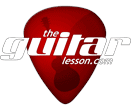
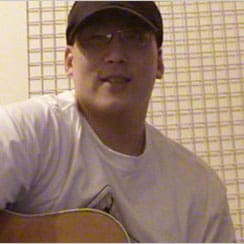
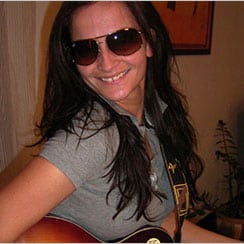
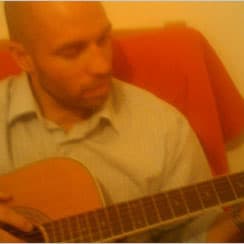
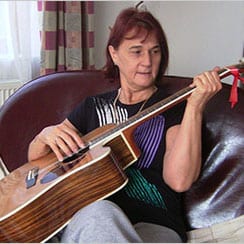
Leave a Reply